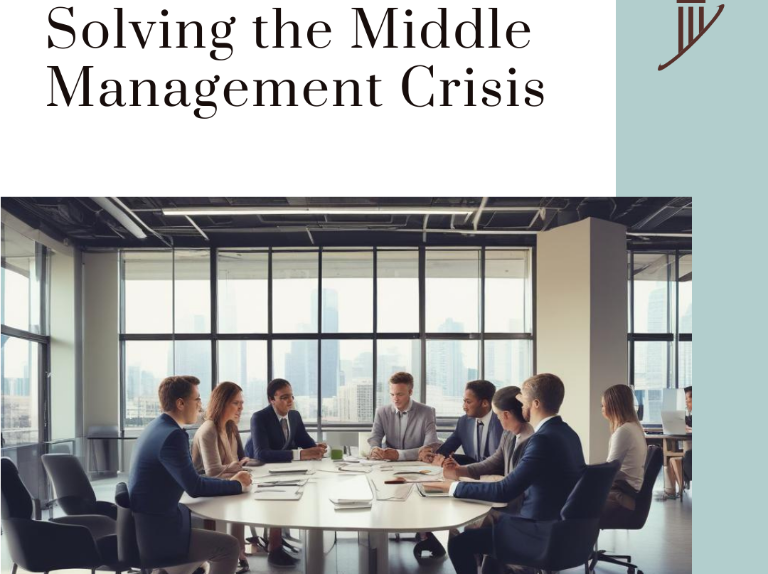Solving the Middle Management Crisis: A Leadership Imperative

Middle managers are the backbone of translating strategic vision into operational execution in every organization. However, the growing phenomenon is that many organizations are experiencing a middle-management crisis. They often see their middle management as a burden with low appreciation and stuck in positions with high accountability but little authority. If this crisis is not addressed, it will only further lead to disengagement, high turnover, and diminished organizational performance.
Solution of this problem should not just be an issue of HR, but a business imperative for CEOs and decision-makers. A strong and empowered middle management layer drives efficiency, innovation, and stability of the workforce. This article looks into how business leaders can assume the recognition, treatment, and prevention of the middle management crisis to guarantee their long-term success.
The Business Impact of a Struggling Middle Management
A disengaged middle management tier can have far-reaching consequences, including:
• Reduced Operational Efficiency: Poor execution of strategic plans due to misalignment between leadership and teams.
• Lower Employee Engagement: When middle managers struggle, their teams suffer, leading to decreased morale and productivity.
• High Turnover Costs: Disengaged middle managers often leave, taking institutional knowledge with them and increasing hiring costs.
• Weakened Leadership Pipeline: If middle managers are not developed and retained, organizations face a future leadership vacuum.
Ignoring this crisis can lead to long-term instability and missed business opportunities.
How CEOs and Decision-Makers Can Address the Middle Management Crisis
1. Grant Middle Managers More Decision-Making Power
One of the biggest pain points for middle managers is the expectation to deliver results without having real influence. Organizations must:
• Clearly define their decision-making scope and empower them to act independently within set parameters.
• Reduce bureaucratic bottlenecks that slow down execution and frustrate managers.
• Foster a culture where leadership values and implements feedback from middle managers.
2. Invest in Leadership Development Beyond Senior Executives
Most leadership training focuses on top executives, leaving middle managers to "figure it out." To change this:
• Implement structured leadership training for middle management.
• Encourage cross-functional exposure to develop broader business acumen.
• Establish mentorship programs where senior leaders guide middle managers on career progression.
3. Redesign Career Growth Pathways
Middle managers often struggle with career stagnation, which impacts motivation and retention. CEOs must work with HR teams to:
• Create clear, structured career pathways leading to senior leadership roles.
• Offer lateral movement opportunities in different business functions.
• Recognize and promote high-performing managers based on merit rather than tenure.
4. Streamline Communication and Reduce Bureaucratic Complexity
Middle managers are often stuck relaying information up and down the chain without real influence. To fix this:
• Implement direct communication channels between executives and middle managers.
• Reduce unnecessary layers of approval to improve agility.
• Foster a culture of transparency where middle managers feel heard and valued.
5. Reduce Administrative Burdens and Optimize Workloads
Many middle managers get caught up in administrative work, leaving little time for leadership. Organizations should:
• Leverage automation tools for reporting, approvals, and performance tracking.
• Encourage effective delegation within teams to avoid micromanagement.
• Reassess and refine job roles to ensure managers focus on strategic execution rather than administrative overload.
6. Prioritize Well-Being to Prevent Burnout
Burnout is a major factor driving middle management disengagement. CEOs must:
• Encourage work-life balance and offer flexibility where possible.
• Provide access to mental health resources and stress management programs.
• Cultivate a supportive work culture that values long-term performance over short-term output.
Final Thoughts: A Leadership-Driven Solution
The middle management crisis is not just an HR issue—it’s a strategic challenge that requires CEO-level intervention. Empowered, engaged, and motivated middle managers drive business success, employee retention, and leadership continuity.
Rethinking decision-making structures, investing in developing leadership, and optimizing workloads: CEOs can transform middle strata thrash poor execution and innovation into a powerhouse of such. In the end, it is those organizations that will solve this crisis today that will create the most resilient high performance organizations in the future.
Is your organization empowering its middle managers, or are they being set up to fail?
HRInc Services : IT Recruitment | Non-IT Recruitment | International Recruitment | National Recruitment


